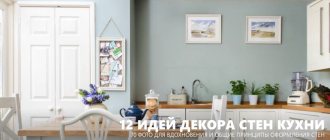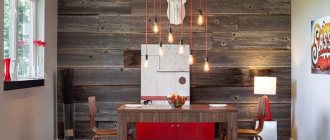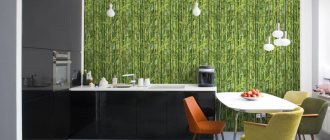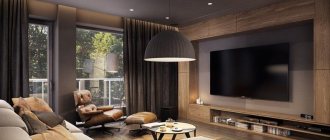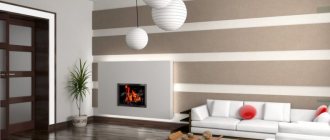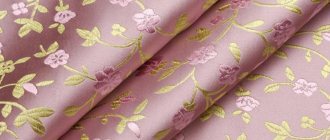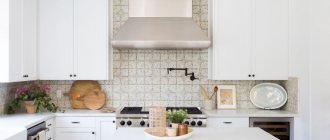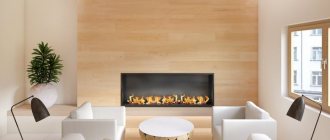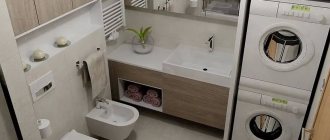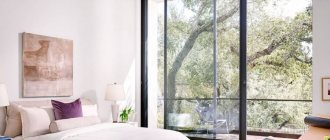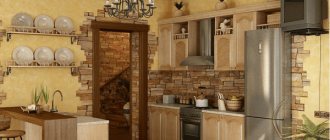12/16/2020 Read in 7 minutes.
The most beautiful and amazingly original kitchen designers are waiting for you in our new article about stylish kitchen decoration. We have collected for you 50 interesting projects with fashionable finishing of aprons, walls, floors and ceilings from the Fundament Group of Companies. Let's take a look at them!
Features of wall decor in the kitchen
The room cannot boast of a good microclimate. Here the temperature can rise or fall sharply, humidity increase, juice begins to splash or fat begins to fly.
Therefore, the wall decoration should be ready:
- Withstand changes in temperature and humidity;
- Does not require complex maintenance, especially in the work area;
- Do not absorb odors and fat;
- Do not become a breeding ground for bacteria.
It should also complement the existing interior and please the owners.
Selection of tiles and mosaics for finishing work
The popularity of ceramic tiles and multi-colored mosaics as facing materials for kitchen interiors is an indisputable fact. The kitchen apron is decorated with stone or ceramic tiles. The reason for such demand for tiles as a finishing material is explained by its unique decorative and technological properties:
- long operational period;
- ability to withstand significant temperature changes;
- resistance to hot water, grease, and other factors;
- ease of maintenance, the possibility of using abrasive detergents during the cleaning process;
- wonderful range of textures and colors;
- unique compatibility with various decorative materials
Color spectrum
There are no special rules for choosing the color scheme of kitchen walls.
A home catering unit will look great with:
- Familiar white shades, increasing the existing volume and giving more light;
- Pastel colors that create warmth and comfort;
- Bright colors that stimulate the appetite and lift your spirits.
The colors of the green spectrum have become popular: mint, meadow, pistachio, and the color of unripe lemon.
In spacious rooms, you can use several colors at once to separate the dining and work areas.
In a small kitchen, a more elegant apron becomes a prominent spot, and all other surfaces are tried to be made just a background for the furniture. Space and tranquility will be provided by a completely monochromatic wall decoration, slightly diluted with a kitchen set.
Painting walls with a natural stone accent
An interesting design can be obtained by combining artificial stone and decorative plaster or paint. In order to choose the desired shade, you can use the base color and add a certain shade to it.
Attention! Before you start painting the walls of the kitchen space, you need to carry out serious preparatory measures.
Only even and smooth walls are suitable for painting, otherwise it will be difficult to expect an aesthetically pleasing appearance of the kitchen. Only washable and moisture-resistant paints are suitable for decorating the kitchen space. Regarding the color palette, professionals do not undertake to give advice to homeowners; they need to focus on their own taste preferences.
Using different shades, you can highlight several separate zones in one space, intended for different areas of activity.
Advice! When choosing paints for decorating the walls of the kitchen, you must take into account that shades of green and blue will reduce your appetite. Orange and red colors promote positive emotions and stimulate appetite.
When choosing a color palette for walls, it is necessary to take into account the range of furniture facades. For a bright set, the optimal solution would be to choose a neutral, light palette of finishing materials for the walls. But for a dull furniture ensemble, you can purchase bright wallpaper with vertical stripes, decorative patterns and reliefs.
Tile
Durable, durable and practical, tiles remain the most attractive material for kitchen decoration. She:
- Not afraid of moisture, temperature, cleaning, dirt;
- Does not absorb dust and odors;
- Can be easily washed with plain water and chemicals;
- Has many colors and patterns.
The entire room is rarely tiled; in this case, the kitchen will look too much like a catering establishment. Basically, durable material is used to decorate the cooking area.
If you want to make a very unusual design using a ceramic coating, then choose tiles with patterns. Most often, classic and ethnic interiors are decorated in this unusual way.
The disadvantage of tiles will be their high cost and the requirement to hire professional tilers.
Paintings and accessories
Anyone who has never seriously wondered about kitchen decor will probably be surprised how many options there are. First of all, these are, perhaps, paintings and wall clocks. Dishes take an honorable second place: decorative plates on the wall or shelves, clay utensils, beautiful service behind glass facades. The option of hanging dishes on a perforated board is becoming increasingly popular. Not the least place in kitchen design is occupied by products made from coffee beans: paintings, topiaries, sculptures. Chic installations of cutlery will add some zest.
Kitchen decoration can be anything, including children's crafts. Often craftswomen make decor with their own hands. On the Internet you can find many master classes on decorating bottles, cups, chairs and windows. There may be room for fresh flowers on the kitchen windowsill. Gardens made of succulents, which are often decorated with small fairy-tale houses made from natural materials, look very interesting.
Of course, the decor must match the overall style of the interior. If the kitchen is the epitome of high-tech, then it is unlikely that bundles of garlic and colored still lifes would be appropriate. But an abstract painting or a forged holder for wine glasses and wine bottles would be a good addition.
Kitchen Accessories are a whole world of devices designed to make life easier for the housewife. They make the environment more practical and functional. These are dispensers for soap, detergents and food products, cutting boards, baskets, sink colanders, trays, trash cans, bread bins, cutlery trays, dish baskets and of course roof rails. All these items can be made of solid wood, metal, plastic, tempered glass.
Plastic panels
Another durable way to create the most unusual kitchen design is to use plastic panels. They can imitate marble, wood, frescoes, fabric or be extremely artificial, which is especially suitable for modern designs.
The advantages of this design are:
- Easy to clean;
- Calm attitude towards moisture, temperature, dirt, aromas;
- Easy installation;
- Low cost.
However, the coverage:
- It is not a very environmentally friendly material;
- It will take up space to create the sheathing;
- Accumulates moisture under the surface and therefore requires regular ventilation.
This type of finishing is especially in demand in spacious rooms designed in minimalist or high-tech style. In this case, choose plain glossy panels that expand the walls of the room and add light.
Kitchen decoration: TOP 10 options for an apron in different materials
view album in new window
In the photo: Kitchen renovation with Moroccan emerald tiles on the backsplash and marbled porcelain tiles on the floor
Designing a kitchen backsplash, walls, floor and ceiling in a kitchen is a challenging task for an interior designer. First of all, you need to consider the practicality of the relief and surface of each material. Secondly, make sure it is durable and can be properly maintained. Then you need to match the materials to each other and to the kitchen unit, taking into account the color scheme, style and different types of lighting.
Kitchen apron decorated with white tiles with geometric patterns
view album in new window
In the photo: Design project of a kitchen-living room decorated with light tiles for the apron and floor
Ordinary tiles can also be interesting. For example, it can be with an unusual ethnic ornament, with an original gold coating, made up of tiles of different shapes, or just imitate this effect. For example, in the design project in the visualization above you see just such an example of a geometric pattern.
Stylish wall design in porcelain stoneware imitating beige and chocolate marble
view album in new window
In the photo: Porcelain tiles imitating chocolate and beige marble in the kitchen decoration
Natural granite for finishing countertops and aprons in the kitchen
view album in new window
In the photo: Natural granite in the design of the apron and countertops
Natural stone is an excellent solution for luxury interior design. More practical, durable and wear-resistant, it also visually looks more elegant and luxurious.
Mirrored splashback with geometric tiles in art deco style
view album in new window
In the photo: Mirror design of a kitchen apron in the art deco style
An unusual mirrored splashback can make your Art Deco interior truly glamorous and unique. Just look at these mirrored geometric tiles - they look absolutely stunning!
Semi-precious blue agate porcelain tiles
view album in new window
In the photo: Fashionable designer kitchen decoration 2022
Porcelain tiles with imitation stones of special types (agate, labradorite, onyx, quartzite and others) can become the focal point of the interior composition, especially when it comes to the design of the apron.
Mirror tiles to frame the backsplash under the cabinets
view album in new window
In the photo: Luxurious kitchen decoration with gilded mirrors
Fashionable mirror tiles can be used both for the apron and for the dining area, adjacent living room and hallway. As a result, the interior will turn out to be very sophisticated and sophisticated.
Moroccan hand fired tiles
view album in new window
In the photo: Fashionable tiles for a green apron
Moroccan tiles with a handmade effect are original tiles with the effect of uneven firing, where each individual tile has a unique shade, as well as ombre transitions in halftones.
Glass splashback for the kitchen in gray
view album in new window
In the photo: Glass kitchen apron in gray color
To maintain perfect order in the kitchen, a glass apron is perhaps one of the most practical and simple finishing options. And it looks very modern!
Glass mosaic panel with floral pattern
view album in new window
In the photo: Glass mosaic panel for finishing the apron
On the other hand, a mosaic panel is a very complex element, often requiring handmade work or a ready-made panel, for example, from a famous Italian brand. Fine details create a super detailed and artful finish. This apron looks more exclusive.
Gray marble-like porcelain tiles in tandem with mirror tiles
view album in new window
In the photo: Modern kitchen decoration in a combined style
The last option in our selection of aprons is the most common marble-effect porcelain stoneware nowadays. But in this project, our designers complemented it with mirror tiles in the upper part. And for the floor, onyx porcelain tiles are used here.
Wallpaper
The ancient method of wall decoration still remains popular. Wallpaper:
- They are low cost, easy to apply and remove;
- They have the largest possible number of patterns and color varieties.
This finish is perfect for any interior; it goes well with wood and its imitations, plaster, plastic, and paint.
The disadvantages of wallpaper are manifested in the relative fragility of the coating, which does not particularly like high humidity and temperature, splashes and other unpleasant moments of living in the kitchen space.
Paper sheets are especially susceptible to abrasion, non-woven fabrics feel better, and vinyl wallpapers are as calm as possible about all the nuances of life in the kitchen.
But foamed vinyl will not provide the opportunity to remove moisture from the walls, as a result of which mold may appear in the room, and soot will gradually accumulate in the relief patterns.
Fiberglass wallpaper will create an unusual design.
Such canvases:
- They are not afraid of absolutely any climate disasters;
- Can be repainted up to 10 times, quickly changing the mood of the kitchen;
- Wash with water and household chemicals.
But the high price of such a design stops most housewives from immediately purchasing this coverage.
Interior decoration of kitchen walls: wallpaper, mirrors, paint, decorative plaster
view album in new window
In the photo: Idea for decorating a kitchen in gold color
Kitchen design largely depends on the chosen finishing materials. The color of the floor and walls affects the overall mood of the interior as much as the set itself. At the same time, the decoration of kitchen walls can be very diverse: tiles, porcelain stoneware, wallpaper, paint, brick/stone/concrete/wood panels can be combined in different proportions and styles.
Italian version: Calacatta Gold marble-effect porcelain tiles and Venetian plaster
view album in new window
In the photo: Kitchen finishing with marble tiles
The Italian option involves finishing the apron, countertops and floors with porcelain stoneware or artificial marble-like stone of any type.
Urban chic: concrete-look plaster and wooden slatted panels
view album in new window
In the photo: Kitchen design project in a private house
But modern styles prefer a combined finish, where there is plaster to look like concrete or stone, wooden slatted panels, porcelain tiles to look like concrete and wood.
In the rhythm of the loft: concrete-look porcelain tiles for the apron and brick-look panels for the walls
view album in new window
In the photo: Interior design of a kitchen with an island and a dining room
The loft is characterized by brick (and sometimes stone) panels on the walls and imitation concrete in other areas.
French neoclassicism: porcelain tiles imitating white and black marble in wall and floor decoration
view album in new window
In the photo: Design project for a kitchen in a niche with an island and a bar counter
In French styles, artificial stone, Corian, marbled porcelain tiles and natural marble are used for all wet areas.
Art Deco luxury: silk wallpaper with a golden tint and modular tiles in gloss and wood for the floor
view album in new window
In the photo: State dining room in art deco style
In art deco you can find both imitations of marble and more exclusive materials: unusual tiles, expensive wallpaper, panels, slabs of marble/onyx/agate, etc.
Classic in French: moldings with openwork stucco
view album in new window
In the photo: Kitchen design project in a classic style
In a classic style, the interior cannot do without plaster moldings, rosettes and medallions. Openwork stucco creates a special feeling of an interior with history.
Luxury contemporary: innovative 3D molded panels
view album in new window
In the photo: Kitchen interior design in neoclassical style
Unusual 3D panels can now be found in many styles: neoclassicism, loft, minimalism. This innovative material essentially belongs to the contemporary style.
Scandinavian comfort: engineered natural wood flooring boards
view album in new window
In the photo: Fashionable modern interior of the kitchen-living room
Scandinavian comfort implies not only a laconic interior and light colors, but also a psychological orientation towards a feeling of comfort and safety. By the way, warm floors are very important here. And for its finishing, for example, laminate, natural parquet or engineered wood is used.
Provencal atmosphere: panel-type wallpaper and encaustic floor tiles
view album in new window
In the photo: Designer kitchen decoration with wallpaper panels
Encaustic tiles, or rather their imitations, involve ornaments made from different types of clay. In the original, such tiles have slight deviations in symmetry, because they are made by hand. And wallpaper like panels complement this atmosphere with the mood of Provence or the Mediterranean Riviera, to choose from.
Veneziano: Venetian plaster and wallpaper with damask pattern for a niche
view album in new window
In the photo: Venetian plaster with a silver tint
In the design project above you can see the use of damask-type wallpaper for niches and panels in the dining room, as well as decorative Venetian plaster as the main element of wall decoration.
Cocktail Suite: Metal Wall Inserts
view album in new window
In the photo: Metal inserts for walls in gold
Metal inserts for floor, ceiling, wall and furniture designs are very popular in the Art Deco style.
Exclusive art deco: blue marble panels
view album in new window
In the photo: Interior of the formal dining room with a biofireplace in the Art Deco style
A trendy option for wall decoration in this style are slabs for panels made of marble, agate, onyx, labradorite, quartzite and other beautiful ornamental and semi-precious stones.
Wooden panels
Natural material will give the kitchen additional comfort and warmth. It is recommended to use it in spacious rooms in classic or rustic decoration, away from the cooking area. Wood:
- Has increased flammability;
- Doesn't like water;
- Does not tolerate washing;
- Absorbs odors and grease.
Special impregnations will slightly improve the characteristics of the coating, but even in this case the wood will require too much effort to maintain an attractive appearance.
Internal lining with clapboard
Lining also acts as an excellent finishing material. Premises with a similar coating are distinguished by a bright and extremely comfortable design.
In the production of this finishing material, only environmentally friendly wood species that are safe for humans are used. They allow air to pass through perfectly, allowing the underlying wall to “breathe.”
To prevent the growth of pathogenic fungus under the lining, before carrying out repair work, the wall panels should be treated with an antiseptic and antifungal compound.
Cork
A nice material is cork, which is made from tree bark and has all the benefits of wood. She:
- Has an attractive appearance;
- Eco-friendly;
- Not susceptible to tree beetles;
- Not afraid of water;
- Does not absorb odors.
The finish is durable and practical, has excellent sound insulation properties, creates a cozy room, but is quite expensive.
Dye
The most ancient version of kitchen design will help to decorate the room in a familiar or unusual way.
Dye:
- Feels great in any climate change;
- Retains its attractiveness for a long time;
- Does not require hassle or worries.
If desired, a flat surface can be decorated with patterns or stickers, creating the most unique design. The material is perfect for any design style and any area.
Plaster
Simple plaster is once again becoming a popular type of finish and a wonderful addition to any decor. She:
- It does not require special care;
- Not afraid of water and temperature changes;
- Relaxes with odors.
In addition to the usual white and gray plaster, today you can find finishes in almost any color, so that the kitchen space will become quite bright and memorable.
Decorative plaster will create the mood of an ancient castle or an original room decorated in the most unusual way. True, to create such an effect you will need the help of specialists.
Decorating the dining table area
How nice it is to sit at the table and admire the natural landscape and the view of the city. A budget option for decorating the dining area would be to use photo wallpaper. Using wall lighting you can create the illusion of additional space and visually enlarge the room.
Liquid wallpaper
Liquid wallpaper can replace plaster. Their additional benefits include:
- Easy to apply (they don’t even require very careful leveling of the walls);
- Creating a seamless surface;
- Ability to close the most inaccessible places;
- High maintainability.
And if necessary, the wallpaper can be removed and applied in another place.
Stages of painting walls
It is not difficult to paint the kitchen walls with your own hands without involving specialists. Let's look at the stages that make up the work:
- prepare the room - if it is not possible to remove all the furniture, then cover the remaining furniture with construction film and cover the baseboards with masking tape;
- create the necessary climate for working with paint (read the instructions and safety precautions on the label);
- remove the old coating from the walls, fill the defects with putty, and level them with plaster if necessary;
- coat with two layers of primer - this will ensure adhesion of the paint to the base;
- start painting from the window;
- apply paint in two layers, pressing with the roller with equal force;
- for narrow places use a brush.
Kitchen decoration requires a thoughtful and serious approach. The microclimate in your family and the quality of digestion in your household will depend on high-quality materials and colors.
Stone
Stone walls in the kitchen will create an atmosphere of ancient romance or a rough home of Alpine peasants. This effect is achieved due to the area of use of the stone and its shades.
The material can only be used in spacious kitchens and, preferably, only on one wall.
- For a long time, they used stone to decorate the area near the doors and near the stove, without completing the work a little. But today such design is going out of fashion, being replaced by a full-fledged decoration of an accent wall.
- The disadvantages of the stone are its weight, price and massiveness, which visually “eats” part of the available space. Decorative stone can correct this shortcoming, but when choosing this option you should pay special attention to high-quality imitation of natural material.
Kitchen wall finishing options
There are a number of interchangeable design solutions used in renovation, depending on the chosen style and budget.
For painting
A universal option for the kitchen. The painted surface is usually easy to clean and can be easily repaired. The color scheme allows you to choose both neutral shades and accent shades.
The use of wallpaper for painting allows you to create relief and hide defects as much as possible. Plastered and puttied walls made of brick, concrete or plasterboard are also suitable for this finishing method.
The photo shows a brightly painted wall in the dining area.
Decorative plaster
This is a finishing coating that allows you to achieve the necessary visual effect and high quality of the surface layer. You can find out more about the types and methods of application, as well as see examples with photos, in the article.
Decorative stone finishing
Wall cladding with this material as an accent solution will decorate any interior. You can also design an open doorway or arch. The practicality of the stone allows it to be used in the kitchen. Interior solutions with photos are given in the article.
Brick wall
It is a popular solution in kitchen interiors and will fit into any style from loft to classic. As a rule, such a surface is coated with a special varnish or paint.
Wallpaper
Brick
Brick walls will allow you to create a very original room. They look best on accent walls near the stove or dining table. In small rooms, preference is given to white or gray colors; in a spacious kitchen, a brown finish will also look nice.
Brickwork is great for period designs; this material is not used in modern designs.
Decorating the walls in the kitchen will be a fascinating process, and the resulting result, with the right choice of material, will delight the owners of the room for a long time.
Custom solutions for the kitchen
There are several design techniques for using space effectively.
Niche
Kitchen furniture placed in a niche saves space, does not clutter up and allows you to properly zone the room.
With fireplace
A kitchen where a family hearth or its imitation is located will create an atmosphere of comfort and well-being in the home.
Working kitchen wall
In modern kitchens, the surface above the work area is often left open and wall cabinets are not used. The decor can be just a hood or open shelves.
Dinner Zone
The wall on which the table or bar counter is located can be decorated in different ways, from the simplest and most neutral finish with painting or wallpaper, to the original one using decorative plaster, wooden or MDF panels, and brickwork. The main thing is that the surface near the table is practical and easy to clean.
Decoration near the sink
The apron is sewn up with any waterproof material, such as ceramic tiles. You can also cover the surface from splashes with tempered glass or a continuation of the tabletop material.
The photo shows a work area covered with an apron made of tempered glass.
